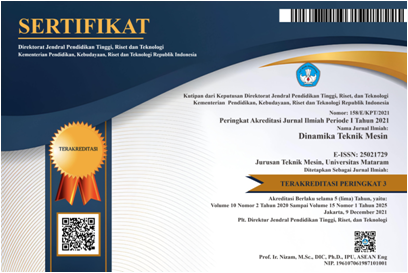Evaluation of Thermal Comfort in Argo Lawu New Generation Train Using Transient CFD Simulation
Abstract
Keywords
Full Text:
PDFReferences
Alhassan, M. I., Aliyu, A. M., Mishra, R., Mian, N. S., Air quality management in railway coaches. 2021 International Conference on Maintenance and Intelligent Asset Management (ICMIAM), 1–5, 2021.
Arfan AP, M. U. H., Optimalisasi perawatan sistem pendingin udara untuk mempertahankan suhu ruangan di mt. hy crystal. Sekolah Tinggi Ilmu Pelayaran, 2022.
ASHRAE, A. H. F., American society of heating. refrigerating and air-conditioning engineers, 1, 2009.
Astuti, R. W., Maureen, A. M., Peran public relations dalam meningkatkan kenyamanan penumpang kereta api indonesia. Jurnal ilmiah mahasiswa komunikasi, 3(2), 42–51, 2022.
Granda, M., Trojan, M., Taler, D., CFD analysis of steam superheater operation in steady and transient state. Energy, 199, 117423, 2020.
Kachhadiya, J.S., Shukla, M., Acharya, S., Singh, S.K., CFD Analysis of ventilation of indian railway 2 tier ac sleeper coach. in recent advances in fluid dynamics: select proceedings of ICAFFTS 2021, 57–71, Springer, 2022.
Komalasih, A. F., Tingkat kenyamanan penumpang pada interior kabin pesawat garuda indonesia kelas ekonomi Jakarta-Makassar di tinjau dari aspek ergonomi. Institut Seni Indonesia Yogyakarta, 2017.
Kwong, Q.J., Yang, J.Y., Ling, O.H.L., Edwards, R., Abdullah, J., Thermal comfort prediction of air-conditioned and passively cooled engineering testing centres in a higher educational institution using CFD. Smart and sustainable built environment, 10(1), 18–36, 2021.
Nasrudin, N., Maryadi, M., Manajemen sarana dan prasarana pendidikan dalam pembelajaran di sd. Manajemen pendidikan, 13(2), 15–23, 2019.
Palmowska, A., Sarna, I., CFD modelling of thermal comfort in the passenger coach. Architecture, civil engineering, environment, 15(4), 133–146, 2022.
Panfilov, I., Beskopylny, A., Tashpulatov, S., Tyurin, I., Numerical simulation of aerodynamics in the cabin of transport. E3S web of conferences, 515, 3020, 2024.
Pradana, M.A., Sulisetyono, A., Studi sloshing tangki lng dengan metode eksperimen dan computational fluid dynamics (CFD). Program studi teknologi kelautan fakultas teknologi kelautan institut teknologi sepuluh nopember, Surabaya, 2019.
Sabtalistia, Y.A., Ekasiwi, S.N.N., Iskandriawan, B., Effect of air conditioning position on thermal comfort in the floor air conditioning system. Applied mechanics and materials, 493, 74–79, 2014.
Suárez, C., Iranzo, A., Salva, J.A., Tapia, E., Barea, G., Guerra, J., Parametric investigation using computational fluid dynamics of the HVAC air distribution in a railway vehicle for representative weather and operating conditions. Energies, 10(8), 1074, 2017.
DOI: https://doi.org/10.29303/dtm.v15i2.1125
Refbacks
- There are currently no refbacks.
Copyright (c) 2025 Open access

This work is licensed under a Creative Commons Attribution-NonCommercial 4.0 International License.






















